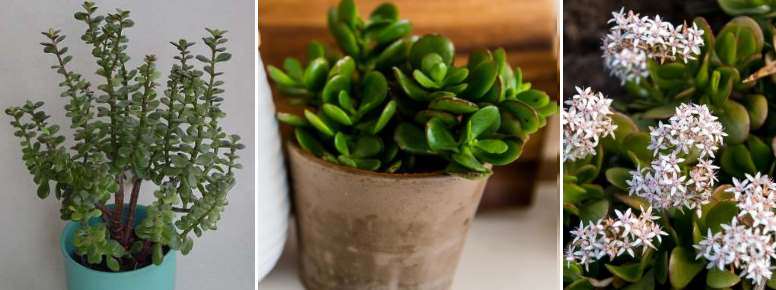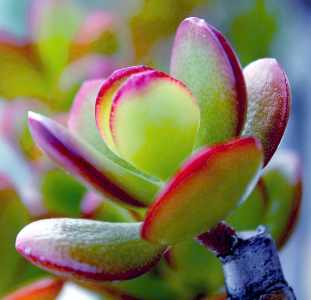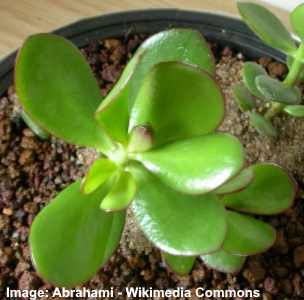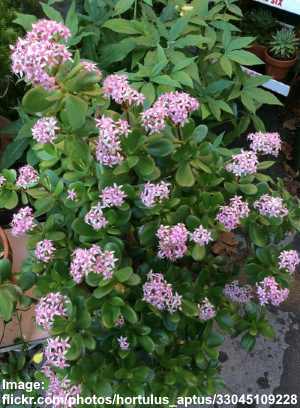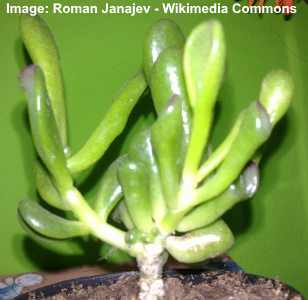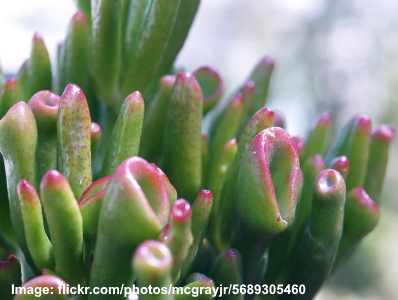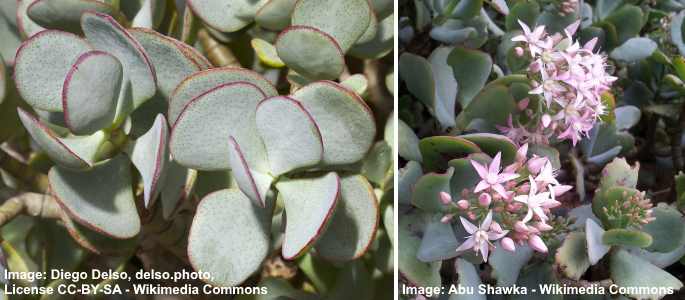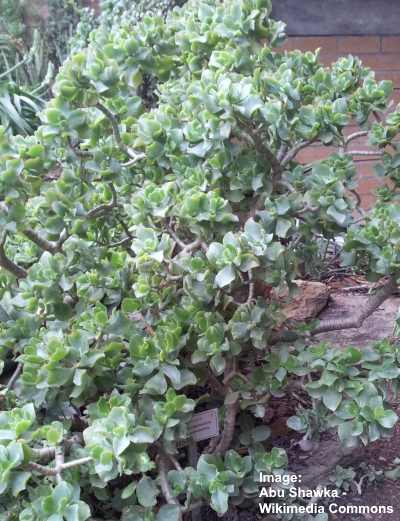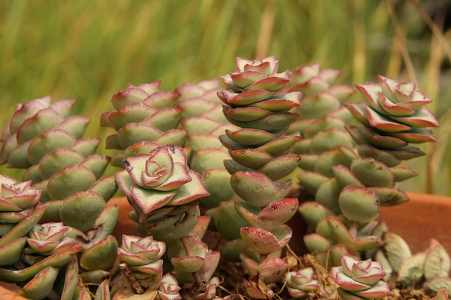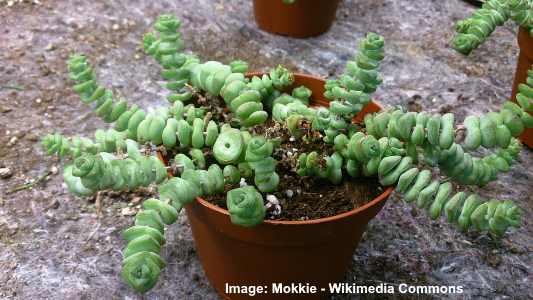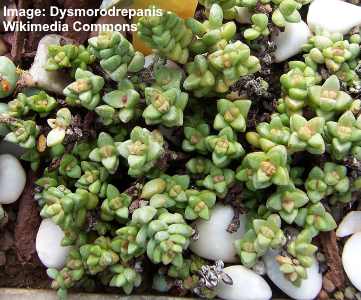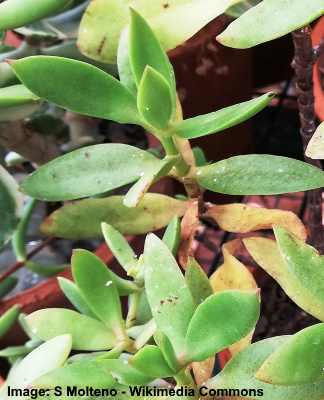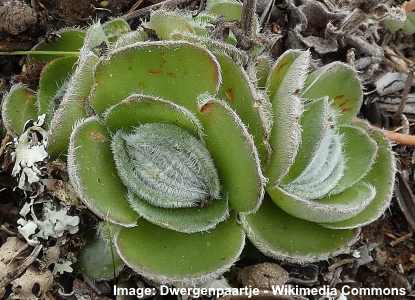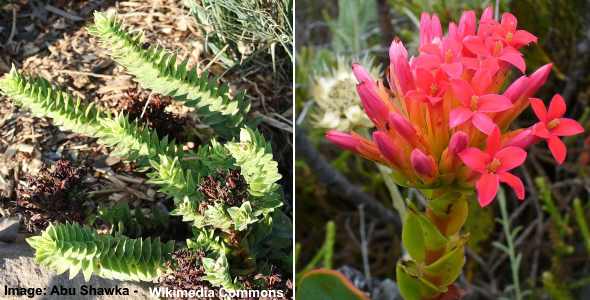Types of Jade Plants (Crassula Varieties) with Their Pictures, Names and Plant Care Guide
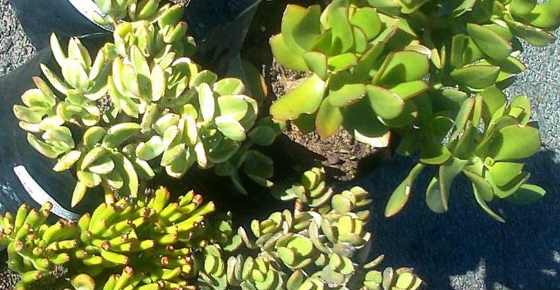
Jade plants are popular houseplants that are very easy to care for and thrive in most indoor environments. One of the most popular types of jade plants is the crassula ovata variety which is also commonly named the money plant, dollar plant, money tree, and lucky plant. This jade plant is not only beautiful, but it is said to invite good fortune and luck into a home according to the Feng Shui. The different types of jade plants grow well in bright areas of the home and are forgiving if they grow in less than ideal conditions.
Jade plants are a species of succulent plants in the genus Crassula and family Crassulaceae. Jade plants and trees are grown throughout the world because some species are associated with wealth and prosperity. You will often see Crassula Ovata cultivars adorning offices and homes. They are also popular gifts at weddings or to new business owners because some people consider them to be lucky plants that help bring good fortune.
It is very easy to care for jade plants and they can even grow in poor light conditions. Occasional watering, light pruning, and keeping them away from direct sunlight is all you really need to do to care for a jade plant. The money plant will ‘reward’ you with lush green succulent foliage that adds beauty to any room.
In this article, you will learn about the many different types of jade plants (Crassula varieties) and how to care for them.
About Jade Plants
Native to South Africa, there are about 200 species of jade plants (Crassula). They get their name from the jade-green colored leaves that are usually tear-shaped, oval-shaped, or wedge-shaped. Sometimes, the leaves can have red blushing around the edges.
In hot tropical climates, jade trees have thick woody stems and smooth shiny green or yellowish leaves. These succulents can have a tree-like appearance and in the wild they can grow up to 8 ft. (2.5 m) tall.
As an indoor plant, jade plants or trees are prized for their ornamental value. Small jade plants grow well in containers and are very easy to look after. Some types of jades (Crassula) have branches like small trees and coin-shaped leaves. Other varieties of jade are low-growing with thick succulent pencil-shaped or spiky leaves.
Depending on how much sunlight they get, the succulent leaves of jades can have red markings around the edges. Some jade cultivars may have yellowish-green leaves and others have bluish-green leaves.
Under the right conditions, jade plants also flower. To see flowers bloom on your jade plants, the nights should be cool and the days bright. Also, dry conditions are needed for a jade plant to flower. This usually happens naturally during the winter. But, if you want your jade plant to blossom with pinkish-white star-shaped flowers in the spring, you can try and mimic these conditions at home.
Types of Jade Plants
Let’s look in more detail at the different varieties of jade plants that you can grow indoors.
Here are the types of jade plants:
Money Plant (Crassula Ovata)
The most popular of all the types of jade plants is the species Crassula ovata, or money plant. Some people also refer to this jade plant as the money tree because it can have a tree-like appearance. However, the ‘true’ money tree plant is the Pachira aquatica.
The money plant has jade-green obovate (tear-shaped) succulent leaves that grow to between 1.1” and 3.5” (3 – 9 cm) long. The leaves can be so numerous that they can make the money plant look like a lush indoor shrub.
The best place in your home for a money plant is in a bright location away from direct sunlight. Followers of Feng Shui say that this “good luck” plant should be located in the “money area” of a home or office.
Money plants have dainty white-pink flowers in the shape of a star and they usually bloom in winter.
Crassula Ovata ‘Lemon & Lime’
If you are looking for a striking variegated jade plant, then the Crassula ovata cultivar ‘Lemon & Lime’ is an excellent choice. This bushy succulent has elongated oval leaves that have lime green and yellowish stripes. The variegated leaves can be up to 2” (5 cm) long and they develop light reddish edges when growing in the sun.
The ‘Lemon & Lime’ jade bush grows up to 4 ft. (1.2 m) tall and can be pruned to keep it small and looking like a shrub.
Crassula Ovata ‘Skinny Fingers’

The ‘Skinny Fingers’ cultivar is similar to the ‘Gollum’ cultivar (left) and the ‘Hobbit’ cultivar (right)
As the name of this jade plant implies, the succulent leaves look like long thin fingers. These jade-colored leaves grow up to 2” (5 cm) long and usually have red tips. The short branches and multitude of leaves give this Crassula cultivar a shrubby appearance.
This is not a mini jade plant, but it also doesn’t grow too large. Expect it to grow up to 3 ft. (90 cm) and, if you are lucky, you may see small star-shaped white or pink flowers in winter.
The ‘Skinny Fingers’ cultivar is similar to the jade ‘Gollum’ and jade ‘Hobbit’ plants.
Golden Jade Tree (Crassula Ovata ‘Hummel’s Sunset’)
The jade ‘Hummel’s Sunset’ cultivar is an award-winning beautiful plant that has golden yellow and green leaves. The beautiful hues of the foliage are a reason why it is also called the ‘Golden jade tree.’
As with many Crassula jades, this variety has thick woody stems and branches. These produce fleshly leaves that are tear-shaped and deep shades of lime green and yellow with red edges, which is more intense during the cooler months. In winter, the lack of sunshine causes the typically golden-yellow leaves to turn a mustard shade of yellow.
Miniature Jade Plant (Crassula Ovata ‘Minima’)
The Crassula ovata cultivar ‘Minima’ is a mini jade plant that has small green and red-pointed leaves. Being a dwarf jade tree, this variety doesn’t grow taller than 2.5 ft. (75 cm) and has a spread of 20” (50 cm).
Compared to common jade plants, the foliage on this miniature jade plant isn’t as dense. This gives the shrub succulent a more tree-like appearance. There is no guarantee that this jade plant will make you richer, but it will enhance the look of any room.
Dwarf Jade Plant (Crassula Ovata ‘Crosby’s Compact’)
The jade ‘Crosby’s Compact’ cultivar looks more like a dwarf succulent shrub than a jade tree. Each branch is covered in light green and red obovate (tear-shaped) leaves, giving the plant a warm cozy look. Compared to other jade plants, this dwarf jade has smaller leaves that grow an inch (2.5 cm) long.
An interesting identifying feature of this mini jade plant is that newly-growing leaves are usually completely red.
Pink Jade Plant
Also called the ‘Pink Beauty,’ this jade plant has more pink colors than jade colors on it. Unlike most other jade plants that have brown stems, this variety has pink-colored stems. The stems produce obovate leaves that are relatively sparse on the colorful stems. This pink jade species is also one of the larger types with a mature plant growing up to 5 ft. (1.5 m) tall.
If you are fortunate enough, this pink jade will reward you with star-shaped pink flowers in winter. These clusters of flowers give off a delightful fragrance and help brighten up rooms on dark winter days.
Gollum Jade (Crassula Ovata ‘Gollum’)
This jade money tree is also called the ‘Finger jade,’ ‘Hobbit’s pipe jade,’ and ‘Trumpet jade.’ All of these alternative names refer to the tubular shape of the jade-green leaves. The thick brown branches contain clusters of succulent leaves that tend to grow near their top.
Another beautiful variety of the ‘Gollum’ jade is the variegated Trumpet Jade. This brightly-colored money tree has fascinating tubular leaves that are yellow and green colored with a hint of red.
For bonsai lovers, the ‘Gollum’ jade species is an ideal type of plant to create a jade bonsai tree.
Jade Plant ‘Botany Bay’
The jade cultivar ‘Botany Bay’ has coin-shaped leaves which is why many associate jade plants with bringing wealth. The slow-growing jade money plant has a shrub-like growing nature and can be easily formed into various shapes.
One of the attractive features of this jade species is the light jade-green foliage with red margins. This red coloring can become more pronounced in winter or in dry conditions.
‘Harbour Lights’
The Crassula ovata cultivar ‘Harbour Lights’ is similar in look and appearance to the ‘Botany Bay’ plant. The long woody stems produce small leaves that have a jade-green and red color.
As with all types of jade plants, the ‘Harbour Lights’ cultivar produces delightful starry pink flowers in winter.
Crassula Ovata ‘Hobbit’
One of the most popular varieties of jade plants to create bonsai trees is the Crassula ovata ‘Hobbit.’ Also, classed as the Crassula argentea ‘Hobbit’, this small money tree has many interesting features.
The green leaves with red tips are somewhat tubular, but they open out at the end and turn back on themselves. This is one of the unique features of this “lucky tree.”
To create a jade bonsai plant, it’s important to trim the jade plant correctly. This can be shaped into exotic and oriental designs to try an invite good fortune and happiness.
Other Crassula Types
Money trees such as jade plants are just one species of plant in the genus Crassula. Let’s look at some other varieties of easy-to-care-for jades that can grace any home or office.
Silver Jade Plant (Crassula Arborescens)
The silver jade plant is also known as the Chinese jade, silver dollar plant, and even money plant. The name for this succulent comes from the grayish-silver leaves that some say is in the shape of a dollar.
Apart from its association with money, one reason why this Chinese jade plant is popular because it is drought tolerant. The silver jade plant grows well outdoors in rock and succulent gardens and also thrives indoors.
Ripple Jade (Crassula Arborescens Undulatifolia)
The twisted appearance of the bluish-green-gray leaves is why this jade shrub is commonly known as the ‘Ripple jade.’ This dwarf variety of jade only grows to about 3 ft. (90 cm) tall and its dense foliage gives it a bushy look.
Even with much trimming and pruning, you could mistake this variety of jade for a smallish bonsai plant.
Crassula Rupestris
The unique feature of the jade species Crassula rupestris (also known as Baby’s Necklace or kebab bush) is the triangular-shaped leaves. Common jade plants tend to have oval-shaped leaves. This species of succulent shrub has leaves in the shape of a triangle.
The unusually colored leaves are another reason why this jade is worthy of attention. Maroon edging on the tips of the leaves contrasts with the greenish-yellow or bluish-yellow leaves.
Crassula ‘Silver Springtime’
Looking at images of this jade plant, you could be forgiven for thinking it’s a different species of succulent and not a type of jade plant. This Crassula succulent has thin stems that are packed with clusters of plump silvery-green leaves.
Due to its dwarf-like appearance, the ‘Silver Springtime’ sits well on office desks, tables, or other surfaces away from sunlight.
Crassula marnieriana (Jade Necklace)
The jade ‘Necklace’ (Crassula marnieriana) is a hybrid of jade plants from the genera Crassula perfoliata and Crassula rupestris. Similar to the ‘Silver Springtime’ jade cultivar, this plant has thin leaves covered in triangular chubby succulent leaves. The jade-green leaves are somewhat smaller than other jade plants and give this succulent a necklace-like appearance.
In winter, beautiful clusters of white starry flowers emerge from the end of the stems.
Crassula Sericea ‘Hottentotta’
Another of the unusual species of jade plants is the ‘Hottentotta’ dwarf variety in the genus Crassula. This small succulent plant looks more like Lithops succulents than a jade tree. Plump fuzzy leaves surround small thin stems that grow in columns. Don’t expect this dwarf jade to grow any higher than 6” (15 cm).
When the ‘Hottentotta’ flowers, it produces clusters of tiny flowers on an elongated flowerhead (inflorescence).
Blush Plakkie (Crassula Cultrata)
Also named the ‘Sharp-leaved Crassula,’ the Blush Plakkie is from the jade species Cultrata. This jade cultivar is identified by its reddish stems and light green elongated tear-shaped leaves. You will also see reddish-brown blushing on the edges of many of the succulent leaves.
This mini jade tree only grows to about 32” tall (80 cm) and looks more like a shrub rather than the classic tree-shape. When it flowers, tiny yellowish flowers grow in loose clusters from the ends of the stems. These can grow up to an impressive 1 ft. (30 cm) long!
Wooly Crassula (Crassula Tomentosa)
One of the most interesting varieties of jade plant is the ‘Wooly Crassula’ from the species Tomentosa. Unlike the leaves on most jade trees, these leaves grow in a rosette shape. The succulent leaves are mostly green, but there can be some red-colored ones there also.
The reason this is called a ‘wooly jade’ is due to the fine hairs that cover the leaves. When mature and flowering, this succulent houseplant can reach heights of 2 ft. (60 cm).
Red Jade Plant (Crassula Coccinea)
If you are looking for a jade plant that has deep red flowers, then the species Crassula coccinea is the best choice. This dwarf succulent shrub has triangular-shaped leaves that form cone-like stems. The jade shrub only grows to about 16” (40 cm) tall.
Unlike most other flowering jade plants, this species blooms in the summertime. Brilliant red flowers top the jade-colored stems that look like an explosion of bright colors.
How to Care for Jade Plants
Jade plants are some of the easiest plants to look after at home. Although they are a symbol of good fortune and prosperity, you don’t have to be “lucky” to care for them properly.
The most important care tip for jade plants is not to overwater them. Wait until 1” to 2” (2.5 – 5 cm) of the soil at the top is dry. Water the plant until all the water drains from the bottom. Wait until the soil has dried out again before repeating the process. In warm summers, this could be every 1 to 2 weeks. In winter, you only have to water a jade plant very occasionally.
Another piece of advice to look after your jade plant properly is to keep it out of direct sunlight. Place in a bright area of your home and keep room temperatures between 60°F and 75°F (15°C to 24°C).
Pruning your jade money tree can help to control its growth and give it a beautiful shape. You can prune back up to one-third of the stems in springtime when it has started growing again. Prune off leggy stems, drooping stems, or overgrowing stems. This will encourage healthy growth and result in your jade plant producing lush dense foliage.
Related articles:

